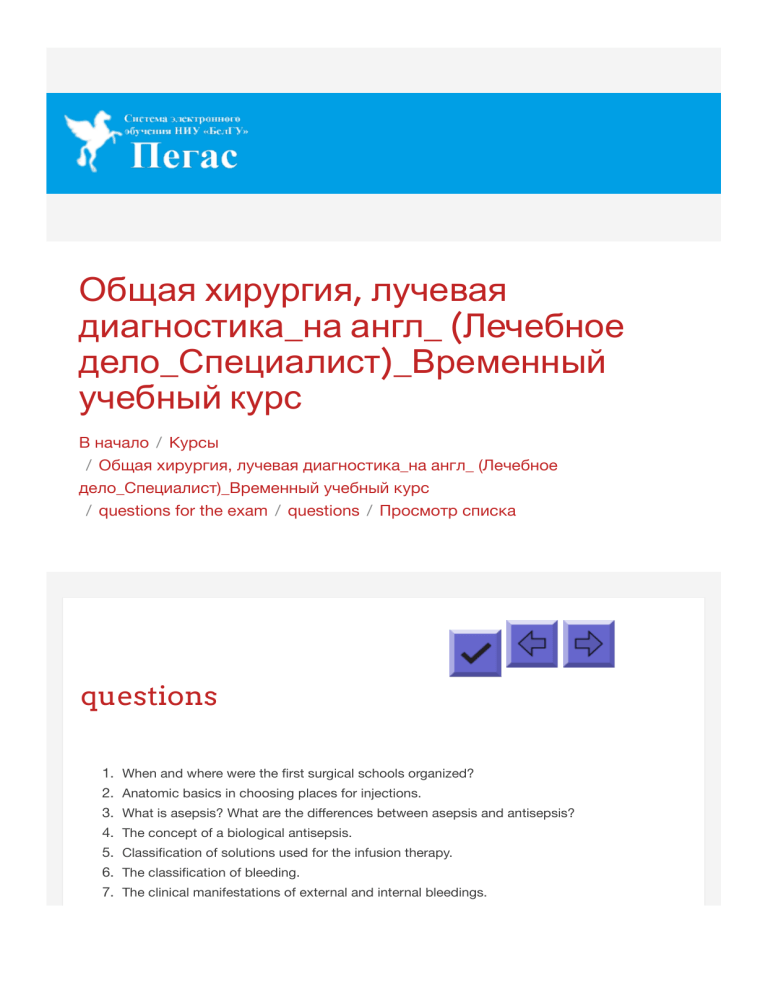
Общая хирургия, лучевая диагностика_на англ_ (Лечебное дело_Специалист)_Временный учебный курс В начало / Курсы / Общая хирургия, лучевая диагностика_на англ_ (Лечебное дело_Специалист)_Временный учебный курс / questions for the exam / questions / Просмотр списка questions 1. When and where were the first surgical schools organized? 2. Anatomic basics in choosing places for injections. 3. 4. 5. 6. 7. 8. What is asepsis? What are the differences between asepsis and antisepsis? The concept of a biological antisepsis. Classification of solutions used for the infusion therapy. The classification of bleeding. The clinical manifestations of external and internal bleedings. Kinds of shock. 8. Kinds of shock. 9. The drugs applied for a local anesthesia 10. The concept of a biological antisepsis. 11. Classification of solutions used for the infusion therapy. 12. The classification of bleeding. 13. Classification of soft tissue injuries. 14. What are the differences between cystic and alveolar hydatid disease (echinococcosis and alveococcosis) according to the development of the embryo. 15. Examination of a patient for septic shock 16. The classification of wounds. 17. What is panaritium (the definition). 18. What is the difference between aerobes and anaerobes 19. Name the causes of peritonitis. 20. Define the concepts of “burn”, “frostbite”, “electric trauma”. 21. clinical symptoms and treatment of a hand phlegmons 22. Principles of the surgical treatment of the thrombosis and the embolism. 23. What are the differences between auto-,iso-, homo-, and heteroplasty. 24. What are the differences between meningeocele and myelomeningocele of the Brain. 25. The classification of anaerobic gangrene. 26. Name the types of pleuritis. 27. The classification of sepsis depending on the duration of the development. 28. Kinds of wound healing. 29. The classification of resistancy to antibiotics. 30. Kinds of narcosis. Devices and methods of inhalation narcosis 31. The principle differences between the concepts of “bandage" and "dressing". 32. The groups of antibiotics 33. Hemotransfusion reactions and complications: prophylaxis, diagnosis, and principles of treatment. treatment. 34. The kinds of the terminal conditions. 35. Indications and contraindications for local anesthesia. 36. Acute venous insufficiency: clinical manifestations, principles of diagnosis and treatment. 37. Clinical and instrumental diagnosis of bleeding. 38. Infection complications of wounds. 39. Classification of osteomyelitis. 40. Tension pneumothorax. 41. Classification of sepsis. 42. The rules of examination of donors, the blood, and its components. 43. The kinds of the acute respiratory failure. 44. Methods of diagnosis of sepsis. 45. List the rooms of a surgical block. 46. Tension pneumothorax. 47. Classification of sepsis. 48. The rules of examination of donors, the blood, and its components. 49. Etiology, pathology, and classification of pericarditis. 50. The estimation of a degree of a bleeding. 51. Hypovolemic shock: reasons, attributes, diagnosis and treatment. 52. Acute anaphylaxis: reasons, attributes, diagnosis and treatment. 53. The reasons of the renal and hepatic failure. 54. Different kinds of wound healin. 55. Complications associated with anesthesia. 56. Traumatic shock: reasons, attributes, diagnosis and treatment. 57. Prophylaxis of postoperative wound infection. 58. The basic complications of antibiotic therapy. : 59. Kinds and forms of the dehydration. 59. Kinds and forms of the dehydration. 60. Methods of temporary and permanent bleeding control. Видимые группы 03011922 Просмотр списка Просмотр по одной записи Поиск Добавить запись × Нет записей в базе данных Дистанционные и электронные образовательные технологии применяются на заочной форме обучения с 2002 года. В НИУ «БелГУ» накоплен огромный опыт в сфере их применения в учебном процессе. Использование современных информационно-коммуникационных технологий позволяет свести к минимуму различия между традиционным (аудиторным) режимом обучения и дистанционным. Подробнее » СВЯЖИТЕСЬ С НАМИ Россия, 308015, г. Белгород, ул. Победы, 85 ! Телефон : (4722) 30-18-78 : " Электронный адрес : sdoadmin@bsu.edu.ru Ресурс управления электронных образовательных технологий. Техническая поддержка: E-mail: sdoadmin@bsu.edu.ru : Переключить на стандартную тему


